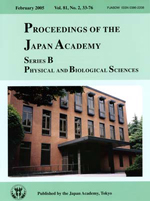All issues

Special Issue
Special Issue
Volume 81, Issue 2
Displaying 1-4 of 4 articles from this issue
- |<
- <
- 1
- >
- >|
Reviews
-
Akira FUJISHIMA, Xin-Tong ZHANG2005 Volume 81 Issue 2 Pages 33-42
Published: 2005
Released on J-STAGE: April 01, 2005
JOURNAL FREE ACCESSAll solid-state dye-sensitized solar cells (DSSCs), which have been pursued just in the past ten years, are reviewed here in terms of the historical background, the present situation and the developmental outlook. Recent efforts to fabricate high-efficiency solid-state DSSCs are summarized in this paper, as well as studies on the long-term operational stability of such solar cells. Studies on the extremely-thin-absorber solar cell (ETA-solar cell) are also reviewed. The operational mechanisms of solid-state DSSCs are compared to those of the liquid counterparts (dye-sensitized photoelectrochemical cells, DSPECs). Two main obstacles to high conversion efficiency of solar energy are highlighted herein for solid-state DSSCs, i.e., insufficient light absorption and large internal recombination loss. Possible resolutions for these obstacles are pointed out.
(Communicated by Kenichi HONDA, M.J.A.)
View full abstractDownload PDF (590K) -
Takeshi YASUMOTO2005 Volume 81 Issue 2 Pages 43-51
Published: 2005
Released on J-STAGE: April 01, 2005
JOURNAL FREE ACCESSHighly complex chemical structures of marine natural toxins involved in seafood poisoning were determined using small samples. The biogenetic process by which the toxins accumulate in fish and shellfish was explained by the food chain. The primary sources of the toxins were identified as dinoflagellates, bacteria, and blue-green algae. The topics related to ciguatera, puffer fish, diarrhetic shellfish poisoning, neurotoxic shellfish poisoning, azaspiracid poisoning, red tides, and Gracilaria red alga poisoning are described.
(Communicated by Saburo TAMURA, M.J.A.)
View full abstractDownload PDF (702K) -
Tamio YAMAKAWA2005 Volume 81 Issue 2 Pages 52-63
Published: 2005
Released on J-STAGE: April 01, 2005
JOURNAL FREE ACCESSThe discovery and structural identification of glycolipids in erythrocyte membranes by the author's research group are reviewed. Differences among species and individuals were the characteristic features of glycolipids in erythrocytes. Individual differences were subjected to genetic analysis and led the discovery of genes involved in the genetic regulation of glycolipid expression in dogs and mice.
(Contributed by Tamio YAMAKAWA, M.J.A.)
View full abstractDownload PDF (850K)
Original Paper
-
Katsushi YOKOYAMA, Sonomi EBIHARA, Tomoko KIKUCHI, Masashi SUZUKI2005 Volume 81 Issue 2 Pages 64-75
Published: 2005
Released on J-STAGE: April 01, 2005
JOURNAL FREE ACCESSFeast/famine regulatory proteins (FFRPs), including of E. coli Lrp and AsnC, compose a diverse family of transcription factors. In this paper aspects of DNA recognition by an archaeal FFRP, FL11 (pot0434017), is reported. By analyzing foot-prints of FL11, two regions are identified as bound by the protein: one in the promoter of fl11 gene, overlapping onto the TATA and B boxes, and the other inside fl11 gene. An assembly of FL11, when binding the two regions simultaneously, may well prevent transcription of the gene, by preventing binding by general transcription initiators, TATA-binding protein (TBP) and transcription factor B (TFB), and by closing the transcription initiation site into the DNA loop formed between the two regions attaching to the FL11 assembly. Two sites, each best protected in each region, have a consensus, TGAAAAWTTTTCA. Relative shifting between foot-prints on the two DNA strands suggests that FL11 faces the DNA into the major groove at the two ends, i.e. at TGAAA and TTTCA, and into the minor groove at the center, AWT. Archaeal FFRPs can be classified into two types, one which binds upstream of the TATA box, at least in some cases, jointly with TBP binding TATA, and another type which covers the TATA box, and further downwards to or inside the gene-coding region. These differences may well coincide with activating or repressing functional differences of the FFRP-promoter combinations.
(Communicated by Masanori OTSUKA, M.J.A.)
View full abstractDownload PDF (1597K)
- |<
- <
- 1
- >
- >|